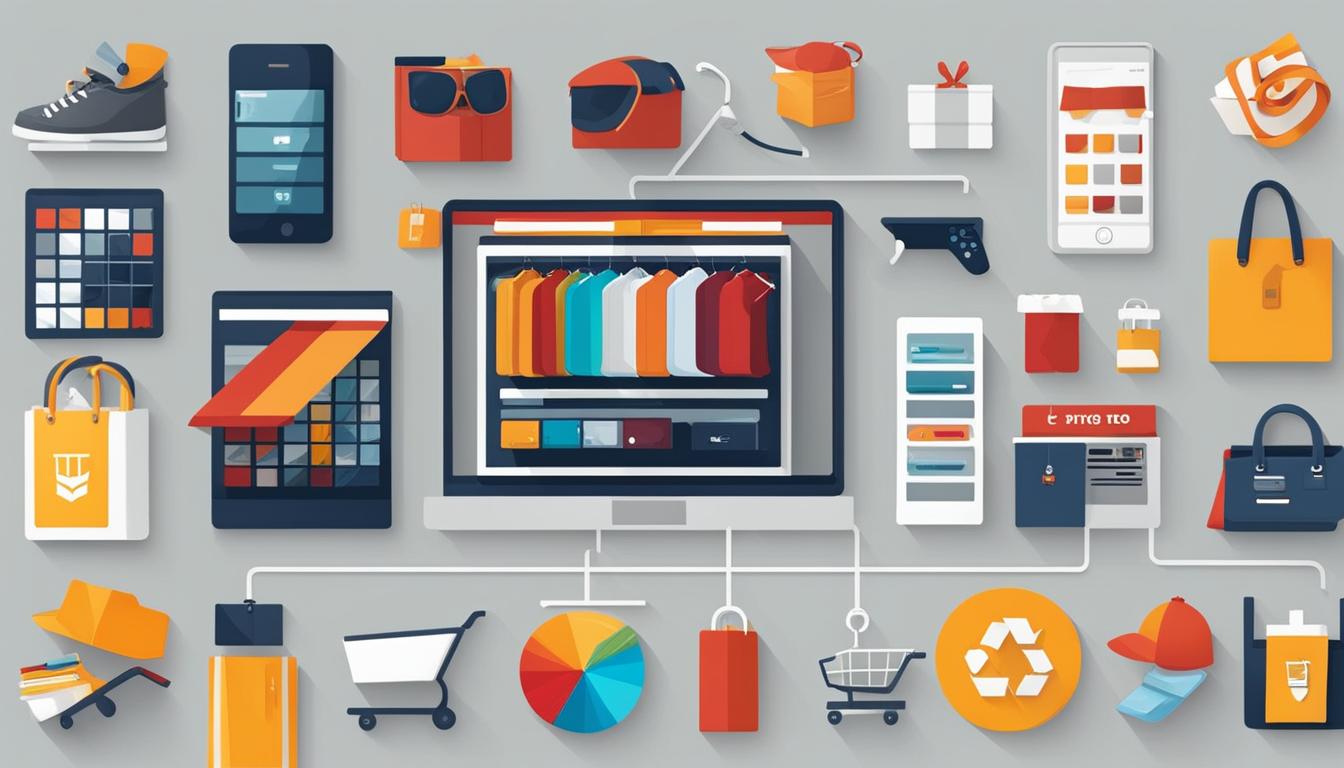Welcome to our article on the differences between physical goods and digital goods in the world of e-commerce. In today’s digital age, businesses have expanded their product offerings to include both tangible and intangible items. Understanding these differences can help you make informed decisions when it comes to your e-commerce strategy.
Physical goods are the tangible products that we can touch and ship to customers, such as tables, chairs, laptops, and mobile phones. On the other hand, digital goods are intangible products that can only be accessed and used online, such as software, ebooks, and video courses. Both types of products have their own unique characteristics and advantages.
Key Takeaways:
- Understanding the differences between physical and digital goods is essential for e-commerce success.
- Physical goods offer a tangible and sensory experience for customers.
- Digital goods provide convenience, scalability, and global market reach.
- Affiliate marketing for physical and digital products has different considerations and potential benefits.
- Balancing physical and digital products in affiliate marketing can optimize earning potential.
Advantages of Physical Goods in E-commerce
Physical goods offer numerous advantages in the world of e-commerce. One of the key benefits is the tangible and sensory experience they provide to customers. Unlike digital goods, physical products can be examined and touched before making a purchase, allowing customers to assess their quality and suitability. This tactile interaction with the product can instill confidence in the buyer and enhance the overall shopping experience.
Additionally, physical goods encompass a wide range of product categories, catering to diverse customer preferences. Whether it’s clothing, electronics, or home decor, there is an extensive selection of physical products available for online shoppers. This variety ensures that customers can find exactly what they are looking for, further enhancing their satisfaction.
When it comes to online shopping for physical goods, one aspect that must be considered is shipping. The shipping process for physical products can differ in terms of cost and delivery time. Factors such as the customer’s location and the shipping method chosen will impact these variables. Nevertheless, e-commerce platforms have made great strides in optimizing their logistics and shipping operations, ensuring that physical goods reach customers efficiently and seamlessly.
Example Product Categories in Physical Goods:
- Apparel (clothing, shoes, accessories)
- Electronics (laptops, smartphones, tablets)
- Home and Kitchen (furniture, appliances, decor)
- Health and Beauty (cosmetics, skincare, vitamins)
- Toys and Games (board games, puzzles, outdoor toys)
By offering a tangible experience, a wide range of product categories, and efficient shipping processes, physical goods continue to be a popular choice in the thriving world of e-commerce.
Benefits of Digital Goods in E-commerce
When it comes to e-commerce, digital goods offer a range of benefits that set them apart from physical goods. These advantages make digital products an attractive option for businesses looking to expand their online presence and reach a wider customer base.
One of the key benefits of digital goods is the absence of manufacturing and delivery costs. Unlike physical products that require materials, production processes, and shipping logistics, digital goods can be replicated and accessed instantly through downloads or streaming. This eliminates the need for inventory management, reduces overhead costs, and allows businesses to offer their products at competitive prices.
Another advantage of digital goods is their global market reach. Unlike physical goods that may have geographical limitations or high shipping costs, digital products can be easily distributed to customers worldwide. This opens up new opportunities for businesses to tap into international markets and reach a diverse range of customers. Additionally, with digital goods, businesses can easily update and scale their products based on customer feedback or changes in market demands, providing flexibility and adaptability in the ever-evolving e-commerce landscape.
The Benefits of Digital Goods in E-commerce:
- Cost savings: With no manufacturing or delivery costs, digital goods offer a cost-effective option for both businesses and customers.
- Global market reach: Digital goods can be easily distributed worldwide, allowing businesses to expand their customer base without geographical limitations.
- Flexibility and scalability: Digital products can be easily updated and scaled based on customer feedback or changes in market demands.
Overall, digital goods present unique advantages in the realm of e-commerce. From cost savings to global reach and adaptability, businesses can leverage these benefits to enhance their online presence and cater to the evolving needs of their customers.

Comparison of Affiliate Marketing Facts for Physical and Digital Products
Affiliate marketing is a popular strategy in e-commerce that allows individuals to earn commission by promoting products and driving sales. When it comes to affiliate marketing, there are several key considerations to keep in mind when comparing physical and digital products.
Affiliate Marketing Facts for Physical Products:
| Manufacturing Cost | Delivery Cost | Store Cost | Commission | Stock Availability |
|---|---|---|---|---|
| Higher | Varies | Varies | Low | May go out of stock |
When promoting physical products, affiliate marketers need to consider the manufacturing cost, which can be higher compared to digital products. Additionally, the delivery cost and store cost may vary, impacting the overall profitability of affiliate marketing for physical goods. The commission rates for physical products are often lower compared to digital products. Moreover, physical products may be prone to going out of stock, which can affect the availability of the promoted products.
Affiliate Marketing Facts for Digital Products:
| No Product Cost | No Delivery Cost | No Store Cost | Commission | Stock Availability |
|---|---|---|---|---|
| No | No | No | High | Always in stock |
On the other hand, affiliate marketing for digital products eliminates several costs. There is no need for manufacturing, resulting in no product cost. Additionally, digital products can be delivered instantly through downloads or streaming, eliminating delivery costs. There are no physical stores required, reducing store costs. As a result, affiliate marketers can often enjoy higher commission rates for promoting digital products. Furthermore, digital products are always in stock, ensuring availability for potential customers.
Overall, when considering affiliate marketing for physical and digital products, it’s important to weigh the advantages and considerations of each. The choice between physical and digital products should be based on factors such as target audience, profit potential, and personal preferences. By understanding these affiliate marketing facts, marketers can make informed decisions and optimize their strategies to maximize their earnings.
Balancing Physical and Digital Products in Affiliate Marketing
When it comes to affiliate marketing, the choice between physical and digital products can significantly impact the success of your strategy. It’s important to consider factors such as customer preferences, market demand, and your own interests and knowledge base. Both physical and digital products have their own advantages and considerations, and finding the right balance between the two can maximize your earning potential.
One approach is to combine physical products with digital products within a specific niche. This allows you to offer a wider range of options to your customers and cater to different preferences. For example, if you’re promoting fitness products, you could include digital fitness programs or ebooks alongside physical exercise equipment. By diversifying your offerings, you can appeal to a broader audience and increase your chances of success.
Another strategy is to focus exclusively on either physical or digital products, depending on your target market and industry. For instance, if you’re in the technology niche, digital products like software or online courses may be more relevant and profitable. On the other hand, if you’re in the fashion industry, physical products like clothing or accessories might be the better choice. Understanding your niche and the preferences of your target audience is crucial in making this decision.
Benefits of Balancing Physical and Digital Products:
- Maximize earning potential by catering to different customer preferences
- Diversify your offerings to appeal to a broader audience
- Take advantage of the benefits of both physical and digital products
- Offer a complete solution by combining tangible and digital experiences
In summary, choosing the right mix of physical and digital products is a key component of a successful affiliate marketing strategy. Whether you decide to combine both types of products or focus on one, it’s important to understand your niche, target audience, and market demand. By finding the right balance and leveraging the unique advantages of physical and digital products, you can optimize your offerings and increase your chances of success in the competitive world of affiliate marketing.
| Choosing Product Type | Physical Products | Digital Products |
|---|---|---|
| Marketing Approach | Focus on sensory experience and tangible benefits | Highlight convenience, instant access, and scalability |
| Customer Preferences | Appeals to those who prefer physical interaction and examination | Caters to tech-savvy individuals who prefer digital convenience |
| Market Reach | Limitations due to shipping and geographical constraints | Global reach with no shipping or geographical limitations |
| Cost Considerations | Manufacturing, delivery, and store costs can impact profitability | No manufacturing, delivery, or store costs, leading to higher commission rates |
| Scalability | May require inventory management and restocking | Easily updated, scaled, and replicated based on market demand |
Conclusion
In conclusion, the comparison between physical goods and digital goods in e-commerce reveals distinct advantages and considerations for businesses. Physical goods provide customers with a tactile and sensory experience, allowing them to examine products before purchase. On the other hand, digital goods offer convenience and scalability, with instant access and global market reach.
When choosing between physical and digital products, businesses must consider factors such as customer preferences, product categories, and business goals. By strategically balancing both types of products, e-commerce businesses can optimize their offerings and maximize profitability. Combining physical and digital products in a niche can provide a wider range of options for customers and increase earning potential.
Ultimately, the decision depends on the individual interests and knowledge base of affiliate marketers. While physical goods may require considerations such as manufacturing costs, delivery costs, and inventory management, digital goods eliminate these costs and provide higher commission rates. Regardless of the chosen product type, having a well-defined affiliate marketing strategy is crucial for success in the ever-evolving e-commerce landscape.
FAQ
What are physical goods and digital goods in e-commerce?
Physical goods are tangible products that can be touched and shipped to customers, such as tables, chairs, laptops, and mobile phones. Digital goods, on the other hand, are intangible products that can only be accessed and used online, such as software, ebooks, and video courses.
What are the advantages of physical goods in e-commerce?
Physical goods provide a tangible and sensory experience for customers, allowing them to examine the items before making a purchase. They also have a wide range of product categories that cater to different customer preferences. Online shopping for physical goods requires shipping, which can vary in terms of cost and time depending on the location.
What are the benefits of digital goods in e-commerce?
Digital goods offer unique benefits such as the absence of manufacturing and delivery costs. They can be replicated and accessed instantly through downloads or streaming. Digital goods also provide global market reach and can be easily updated and scaled based on customer feedback or market demands.
What are the differences in affiliate marketing for physical and digital products?
Affiliate marketing for physical products involves considerations such as manufacturing costs, delivery costs, and store costs, which can impact commission rates. Physical products may also be prone to going out of stock due to the need for manufacturing. On the other hand, affiliate marketing for digital products eliminates product costs, delivery costs, and store costs, allowing for higher commission rates and the assurance that digital products will always be in stock.
Should I focus on physical or digital products in affiliate marketing?
The choice between physical and digital products depends on individual interests and knowledge base. It is possible to combine physical products with digital products in a niche to take advantage of both types. This strategy can offer a wider range of options for customers and maximize earning potential. Regardless of the product type, having a well-defined affiliate marketing strategy is essential for success.



